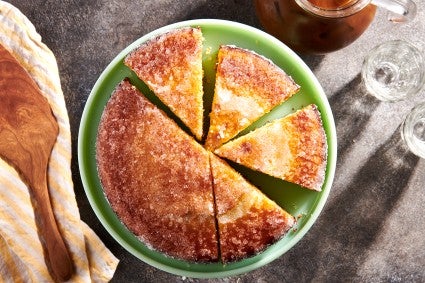The secret to this tender cake is ... pizza flour?
This finely milled flour creates the lightest, most delicate crumb.


I promise our Test Kitchen isn’t trying to trick you.
It seems like it should be obvious: Pizza flour is for pizza and cake flour is for, well, cake. You don’t have to be an experienced baker to figure that one out.
But in a blatant disregard for those “rules,” our new Lemon Ricotta Cake is made with '00' pizza flour.
Lemon Ricotta Cake is a compelling recipe for many reasons: It’s sweet but not sugary, blanketed with a crunchy lemon glaze, and plush from the whole milk ricotta. But its melt-in-your-mouth texture makes it truly stand out, and that all comes down to the flour.
Intrigued by this new recipe, I asked developer Sarah Jampel why she chose '00' pizza flour instead of just cake flour for this ricotta cake. “'00' is softer than cake flour because it’s more finely milled,” she explained. It’s also made of a blend of soft and hard wheat, as opposed to just hard wheat, like all-purpose flour and cake flour are. These traits are meant to make the best pizza, creating an easy-to-handle dough and giving the crust a crisp outer shell. But in this Lemon Ricotta Cake, the soft flour makes the cake’s crumb more tender and delicate. “This cake is so light,” describes Sarah.

In fact, even though '00' pizza flour’s protein content is actually higher than cake flour’s — closer to all-purpose flour, in fact — “the cake made with pizza flour is softer and lighter than if it’s made with cake flour,” reports Sarah. “It will also rise a little bit taller.”
She emphasizes that these differences are subtle — you wouldn’t notice if you didn’t compare the two cakes side by side. So you certainly could use cake flour (the cake will still turn out beautifully), but for the best texture (and if you happen to have some '00' you’re looking to use up), she prefers the pizza flour.
Inspired by the success of '00' pizza flour in her Lemon Ricotta Cake, Sarah tested pizza flour in several recipes originally developed for cake flour — including Tender White Cake and Rhubarb-Ginger Coffee Cake — to see if this flour technique could be applied elsewhere. Unfortunately, it’s not successful in every instance.
“Pizza flour made the cakes extremely soft — softer than versions made with cake flour,” she reported. Good news! But there was a flipside. “Some of the cakes made with pizza flour swapped in for cake flour were so tender that they verged on fragile, and I’d worry about layering with soaks, frostings, fillings, etc. It just doesn't seem like such a delicate cake could hold up,” Sarah says. “Ultimately, I wouldn't recommend a 1:1 swap of pizza flour for cake flour in other recipes.” (And for what it’s worth, you shouldn’t swap cake flour in for '00' when making pizza, either!)
Sarah explained that the reason '00' pizza flour works so well in the Lemon Ricotta Cake is because there’s a lot of structure in the cake from other ingredients, like the ricotta and plenty of eggs. “Because of the support they lend, the softness of the pizza flour is a benefit in this cake,” she says. “In other recipes, it’s more of a liability: The pizza flour is too soft to provide the necessary structure for the cake.” What’s more, the ricotta cake is a single-layer cake with a glaze, not a frosting, so it’s not meant to be stacked or frosted in the first place.
Turns out not every cake can be treated like pizza. But in the case of this Lemon Ricotta Cake, the results are pretty exquisite.
Cover photo by Danielle Sykes; food styling by Kaitlin Wayne.


